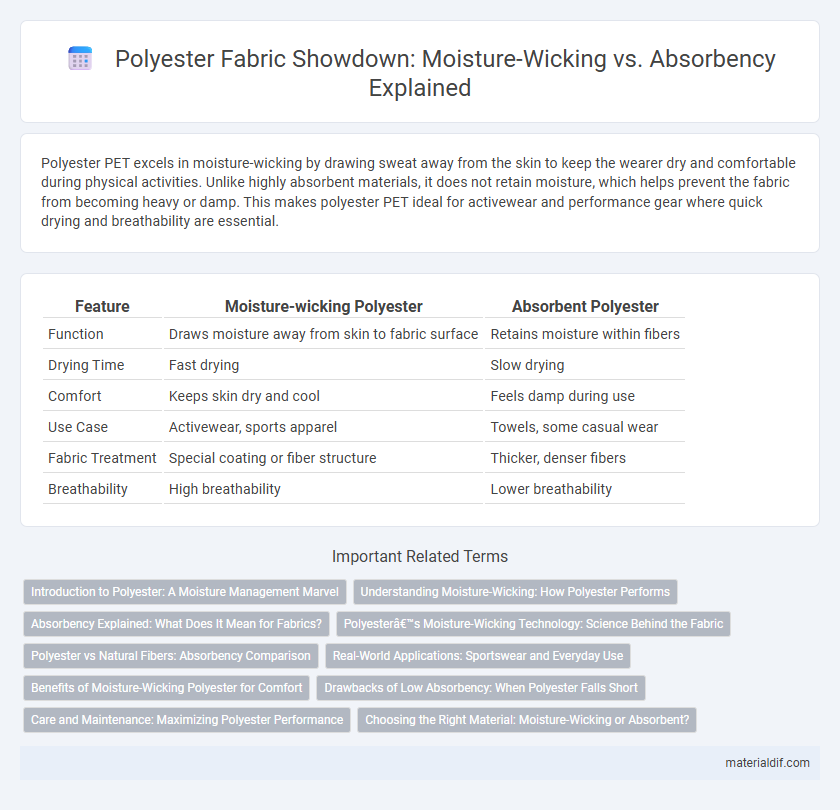Polyester PET excels in moisture-wicking by drawing sweat away from the skin to keep the wearer dry and comfortable during physical activities. Unlike highly absorbent materials, it does not retain moisture, which helps prevent the fabric from becoming heavy or damp. This makes polyester PET ideal for activewear and performance gear where quick drying and breathability are essential.
Table of Comparison
| Feature | Moisture-wicking Polyester | Absorbent Polyester |
|---|---|---|
| Function | Draws moisture away from skin to fabric surface | Retains moisture within fibers |
| Drying Time | Fast drying | Slow drying |
| Comfort | Keeps skin dry and cool | Feels damp during use |
| Use Case | Activewear, sports apparel | Towels, some casual wear |
| Fabric Treatment | Special coating or fiber structure | Thicker, denser fibers |
| Breathability | High breathability | Lower breathability |
Introduction to Polyester: A Moisture Management Marvel
Polyester excels in moisture-wicking by rapidly drawing sweat away from the skin to the fabric's surface, where it evaporates quickly, keeping the wearer dry and comfortable. Unlike absorbent fibers such as cotton, polyester resists retaining moisture, making it ideal for activewear and performance clothing. Its synthetic structure enhances breathability and durability, positioning polyester as a leading fabric in moisture management technology.
Understanding Moisture-Wicking: How Polyester Performs
Polyester excels in moisture-wicking by quickly drawing sweat away from the skin to the fabric's surface, where it evaporates, keeping the wearer dry and comfortable during physical activity. Unlike absorbent materials like cotton that retain moisture, polyester's hydrophobic fibers prevent water absorption, enhancing breathability and reducing drying time. This moisture management property makes polyester ideal for activewear and outdoor clothing designed to maintain dryness and regulate body temperature effectively.
Absorbency Explained: What Does It Mean for Fabrics?
Absorbency in fabrics refers to the ability of a material to take in and retain moisture from the environment or the skin, impacting comfort and drying time. Polyester, known for its low absorbency, resists water absorption, making it quick-drying but less suitable for situations where high moisture retention is needed. Understanding absorbency helps in selecting fabrics for specific uses: high-absorbency materials like cotton offer comfort by soaking up sweat, while low-absorbency synthetics like polyester excel in moisture-wicking and maintaining dryness.
Polyester’s Moisture-Wicking Technology: Science Behind the Fabric
Polyester's moisture-wicking technology leverages hydrophobic fibers that actively draw sweat away from the skin to the fabric's surface where it quickly evaporates, keeping the wearer dry and comfortable. Unlike absorbent materials that retain moisture, polyester minimizes dampness by facilitating rapid moisture transfer and evaporation, reducing chafing and improving breathability. Advanced microfiber constructions and chemical treatments enhance polyester's ability to manage sweat, making it a preferred fabric in performance and athletic apparel.
Polyester vs Natural Fibers: Absorbency Comparison
Polyester fibers exhibit low absorbency, typically absorbing less than 1% of their weight in moisture, which enhances their moisture-wicking properties by quickly moving sweat away from the skin to the fabric surface for evaporation. In contrast, natural fibers such as cotton can absorb up to 25 times their weight in water, leading to slower drying times and increased fabric dampness during physical activity. This contrast makes polyester preferred in performance apparel where moisture management and quick drying are essential.
Real-World Applications: Sportswear and Everyday Use
Polyester's moisture-wicking properties efficiently pull sweat away from the skin, making it ideal for high-performance sportswear and intense workouts. In contrast, fibers with high absorbency, like cotton, retain moisture and are commonly preferred for everyday casual clothing. The choice between moisture-wicking and absorbency depends on activity level and comfort needs, with polyester excelling in activewear for quick-drying and odor control.
Benefits of Moisture-Wicking Polyester for Comfort
Moisture-wicking polyester rapidly draws sweat away from the skin to the fabric's surface, enhancing breathability and keeping the wearer dry. This quick-drying property reduces chafing and discomfort during intense physical activity or hot weather. Unlike absorbent fabrics that retain moisture, moisture-wicking polyester promotes better temperature regulation and prolonged comfort.
Drawbacks of Low Absorbency: When Polyester Falls Short
Polyester's low absorbency leads to moisture staying on the skin, causing discomfort and potential irritation during extended wear. This limited moisture retention impairs the fabric's ability to manage sweat effectively, especially in high-intensity activities. As a result, polyester can sometimes fail to provide the breathable comfort required for optimal athletic performance and everyday use.
Care and Maintenance: Maximizing Polyester Performance
Polyester's moisture-wicking properties rapidly move sweat away from the skin, preventing dampness and enhancing comfort during physical activity. Proper care, such as washing in cold water with mild detergent and avoiding fabric softeners, maintains polyester's wicking efficiency and durability. To maximize polyester performance, air drying or tumble drying on low heat preserves fabric integrity and prevents loss of moisture management capabilities.
Choosing the Right Material: Moisture-Wicking or Absorbent?
Polyester excels in moisture-wicking properties, rapidly pulling sweat away from the skin to the fabric's surface for quick evaporation, making it ideal for activewear and athletic use. Absorbent materials like cotton retain moisture, providing comfort in low-intensity activities but can feel heavy and damp during high-sweat conditions. When choosing between moisture-wicking polyester and absorbent fabrics, prioritize polyester for performance and sweat management, while absorbent materials suit casual wear requiring softness and breathability.
Moisture-wicking vs Absorbency Infographic

 materialdif.com
materialdif.com